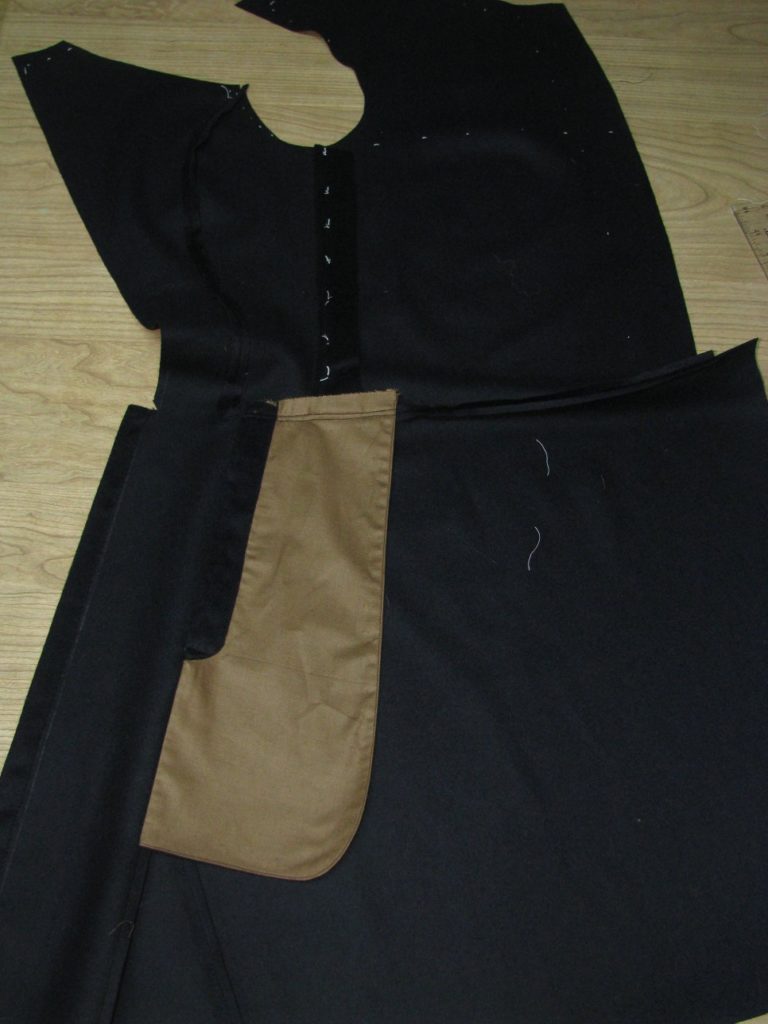Category: Federal Enlisted Frock Coat
Shoulder Seams
Lay the shoulder seams, right sides together. Note how the back seam is longer than the forepart. This will need to be eased in as you baste. Starting at one side, make a few stitches in place with your basting thread, about 3/8 from the inlay. Then carefully baste across, easing the excess fabric in as you go. End with a few stitches in place.

Take your iron and gently iron away the ripples that appear in the fabric. Don’t let the iron go more than one inch away from the seam, or you will press all of the ease out and your work will have been for nothing.
Now sew the seam, with the full side down. Keep the lining and canvas out of the way as you are sewing. Press on both sides to set the stitches, press on the wrong side, and press on the right side with a press cloth. Note the curved appearance and downward angle to the seam, something lacking in many reproductions.
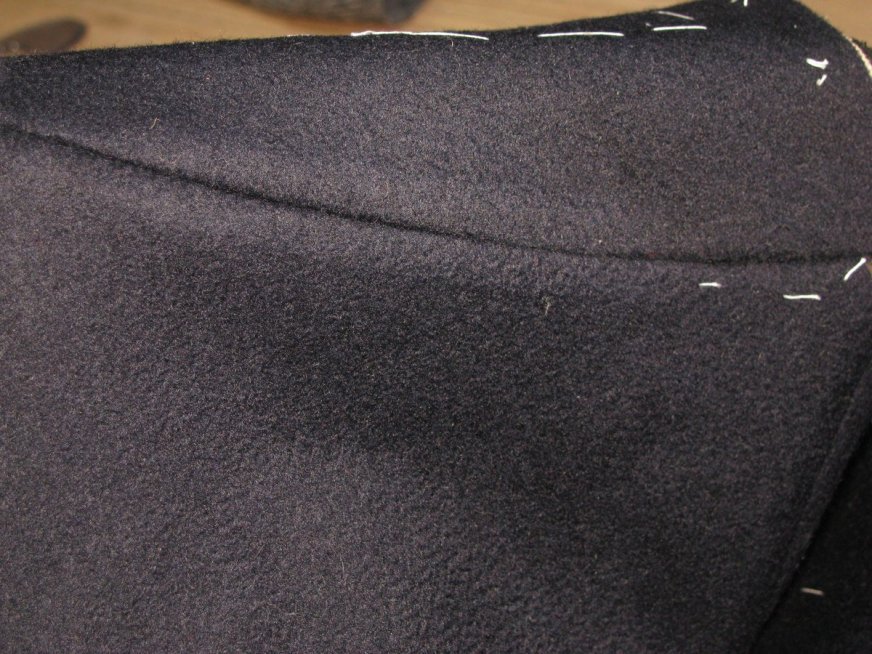
Plait Buttons
It’s now time for a change of pace, sewing on some buttons! The two center back buttons are both decorative, and help hold the junction of the side, back, and skirt together. They add a bit of extra strength. Begin by cutting a length of buttonhole twist, waxed and pressed. Make a knot, and insert your needle from the underside, coming out just below the waist seam in the skirt.
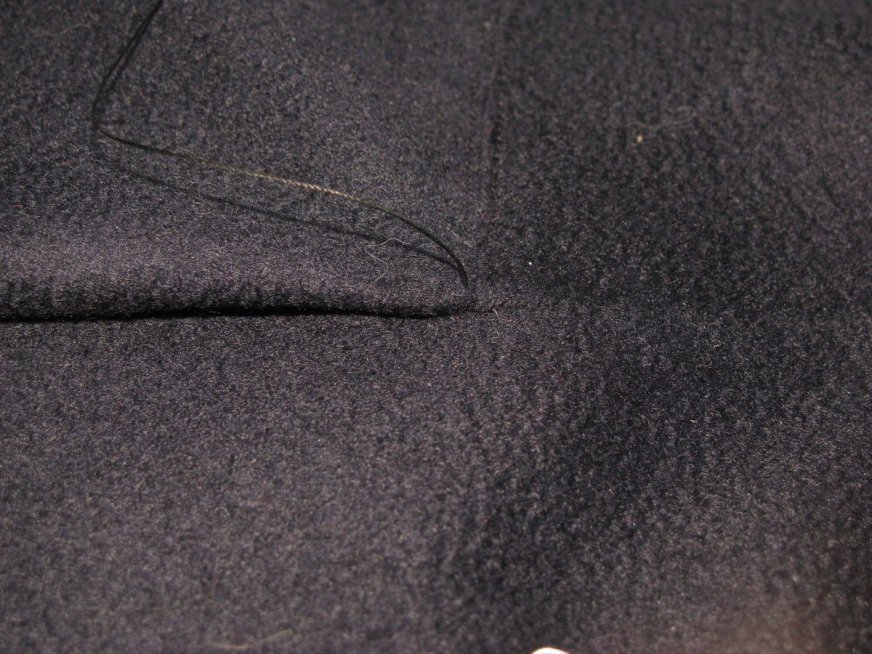
Place the thread through the button, and back into the cloth, just above the waist seam, in the side piece. On the underside, make sure the thread comes out at just about the same place it went in. Repeat this process for a total of six times through the button shank.
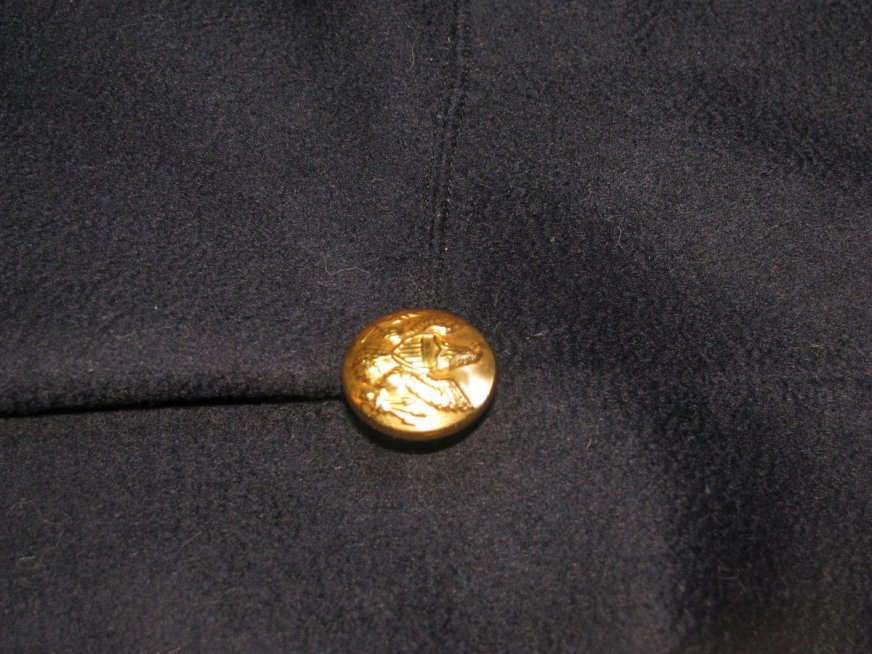
Bring the needle back out as if you were going to do a seventh stitch, but this time, wrap the thread around the stitches you have made already, pulling snuggly as you go. Wrap four times.
This gives extra strength to the button threads, preventing wear and tear. After the fourth time around, insert the needle into the middle of the threads, coming out the other side. Repeat that a total of three times. Then snip the extra thread closely. This prevents the need for an ugly knot on the outside of the coat, and is quite strong. I haven’t had any complaints of buttons falling off in the three years I’ve been using this method.
Installing the Lining
It is now time to insert the lining into the coat. Since we have not closed the shoulder seam, the coat is still flat, allowing the work to progress rather easily. This used to give me a huge amount of trouble when I tried installing the linings after the shoulder and back seams were sewn. It could easily take two hours per coat, whereas now it’s down to about 20 minutes.
Lay the lining onto the wrong side of the coat. If done properly, everything should line up nicely with the forepart, reaching over to the side rear side seam. Baste from the shoulder seam, starting about three inches from the inlay, down to about one inch above the waistline. Then sew towards the top of the side piece, staying in center of the lining as you go. When basting the area over the side piece, don’t forget that this has been shaped with the iron. You may need a hand underneath to support the fabric properly.

Next, baste all around the lining, staying one inch from the edge. At the front, stay on the inside of the tailor’s tacks. At the top of the shoulder, stay three inches from the shoulder inlay.

Hold the coat up at this point, carefully supporting the neck and armscye to avoid unwanted stretching. Check that the coat still drapes nicely, and that the lining is not causing any constrictions in the coat. If so, remove the basting stitches and try again.
Quilting the Lining
Begin by drawing a line four inches parallel from the center front. This is the point at which to stop quilting. Anything in front of in should not be quilted, as we need room to work in there later on.
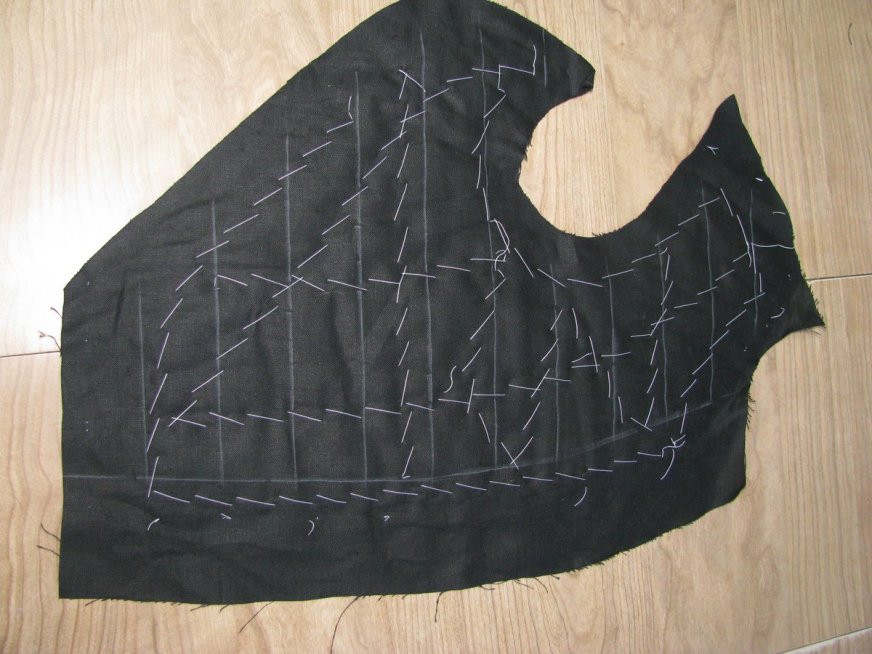
Next, draw the quilting lines, in black chalk. It’s better to use black chalk here so that it won’t be seen in the finished coat. The first line should be drawn, on the grain line, about one inch below the armscye, across the entire lining.
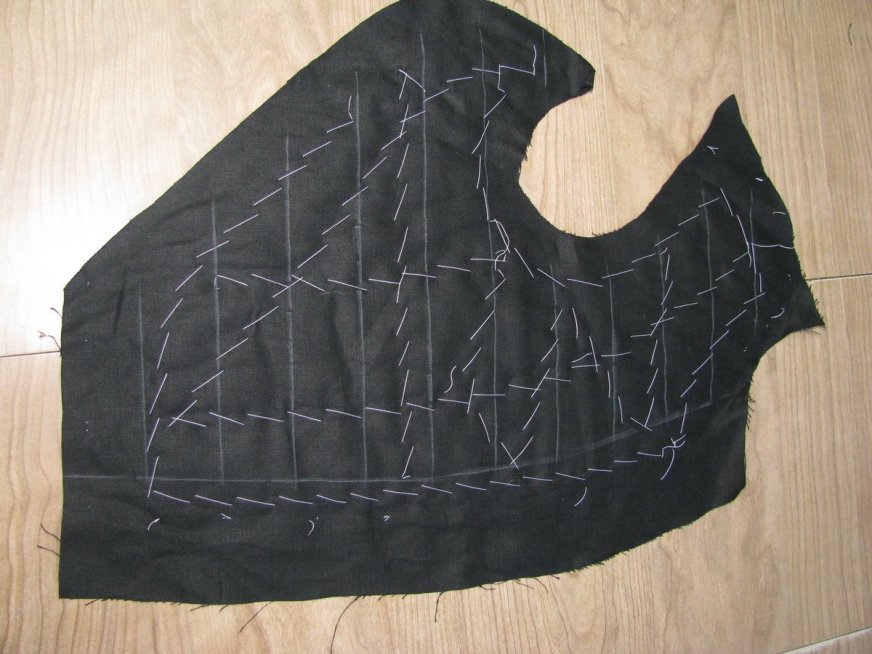
The other lines are spaced from 1 3⁄4 to 3 inches apart, depending on the size of your coat. Don’t forget to mark the top of the scye for quilting.
Finally, quilt the linings. This can be done by hand with a side stitch, for a more flexible, free flowing lining.
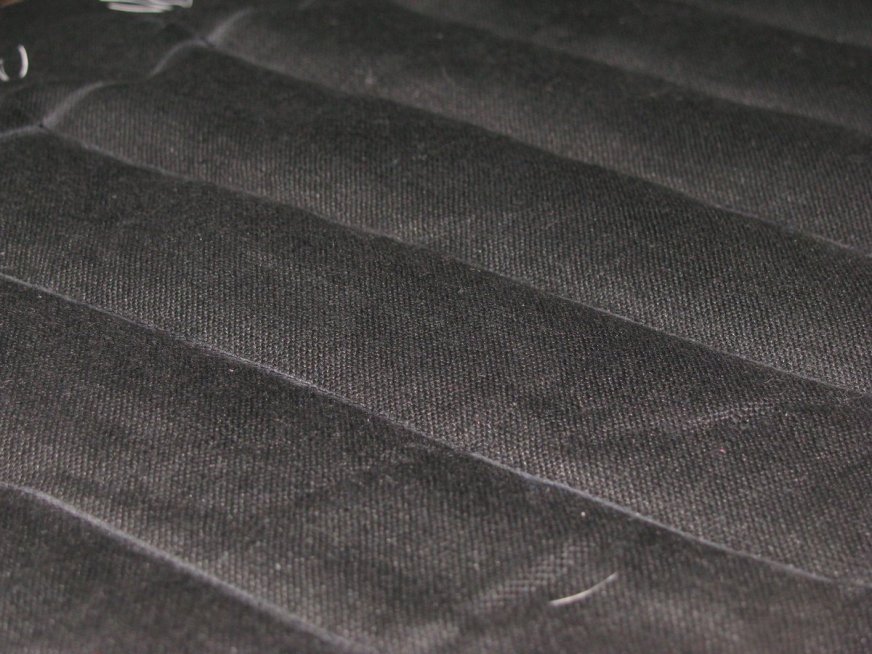
If done on machine, use a small stitch length – 12 to 14 stitches per inch. As you are quilting, make sure the pieces are not bunching up or sliding around. While the basting should take care of most of that, it can still happen. Sew each line, stopping at the center line you drew. Finish the end of each row by hand with a small knot.

Remove all visible basting, cut any stray sewing threads, and give the lining a light press. At the shoulder area, gently stretch the armscye, shoulder seam, and neck as you did for the forepart and canvas.
Assembling the Lining
To begin, ensure you are working on opposite sides of the batting, by arranging the pieces as shown. Place the oval shaped pieces on top, and baste them down around the edges as shown.
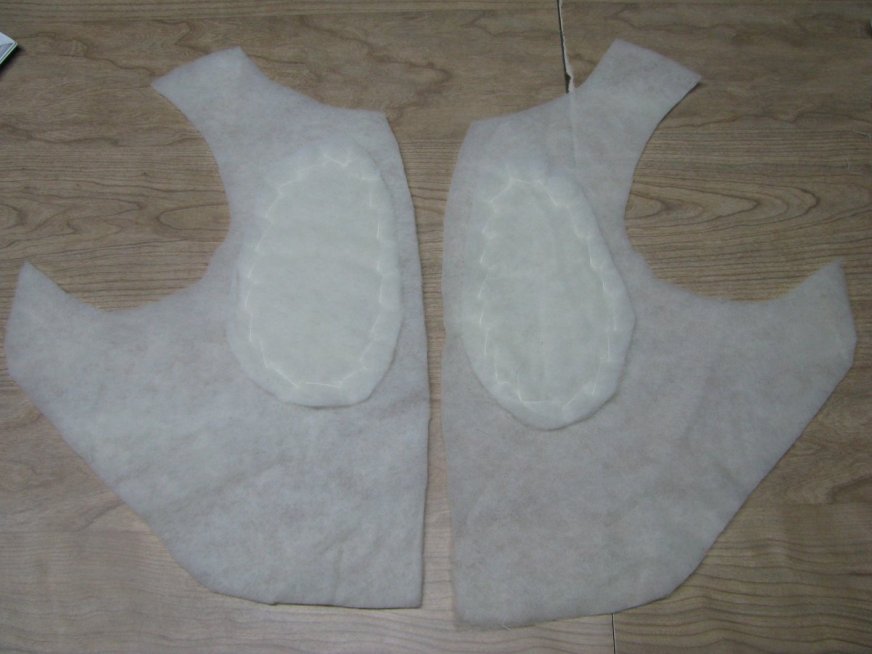
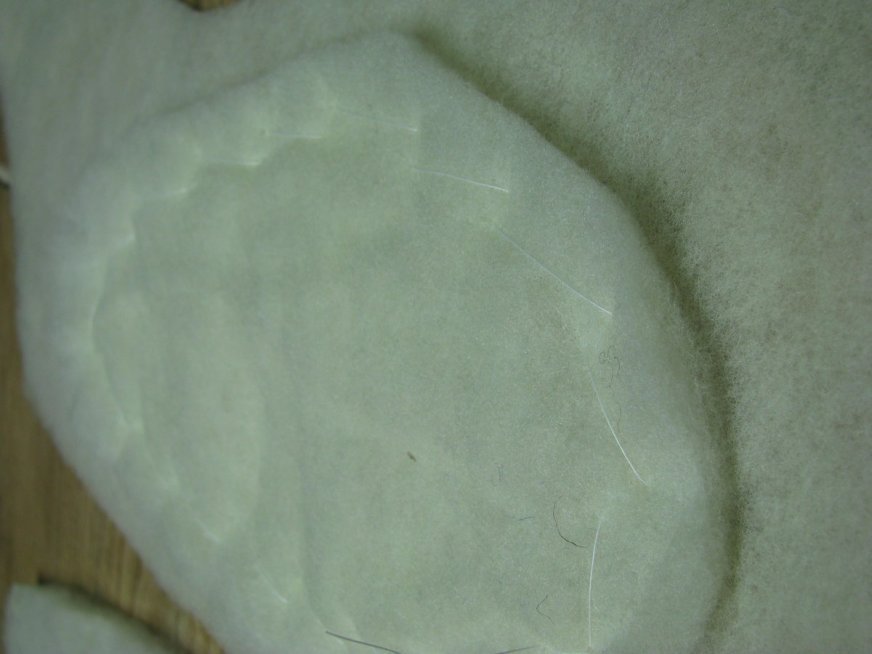
Lay both pieces of batting right down on the sacking, with the smaller piece of batting sandwiched in between. Baste around the edges of the batting. Notice how the sacking extends a half inch in all directions past the wool batting.

Note: I’m using a blue wool flannel for the interlining / sacking here because the client needed to save some money. While not completely authentic, there are cases of coats being interlined with scraps of fabric, and even carpeting material.
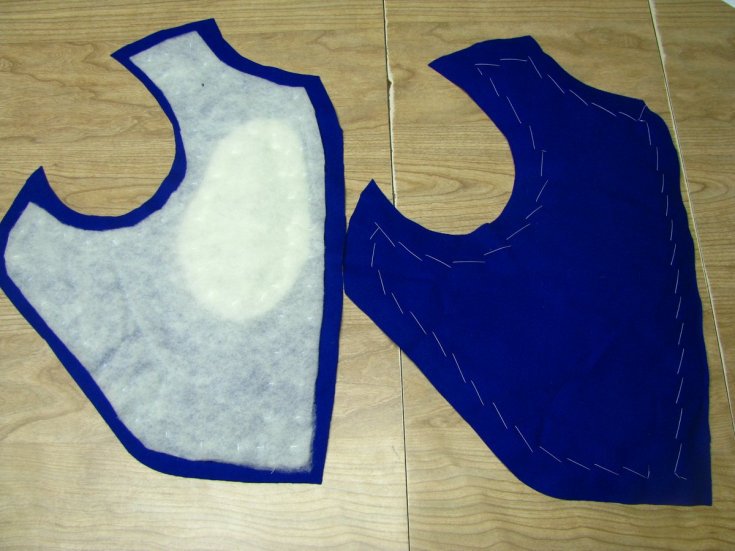
Next, the interlining assembly is placed on top of the lining pieces, with the wool batting in the middle. The interlining should be half an inch from the edges of the lining and inlay markings, except at the bottom, where there is an inch to the inlay. At the front, there should be a half inch between the interlining and inlay, not shown in the photo (a mistake on my part), followed by the two inch inlay on the center front.

Turn this lining assembly over so that the lining is on the top, and baste down the middle of the lining, from the middle of the shoulder seam, down the front, and back up towards the top of the side piece area, as shown.
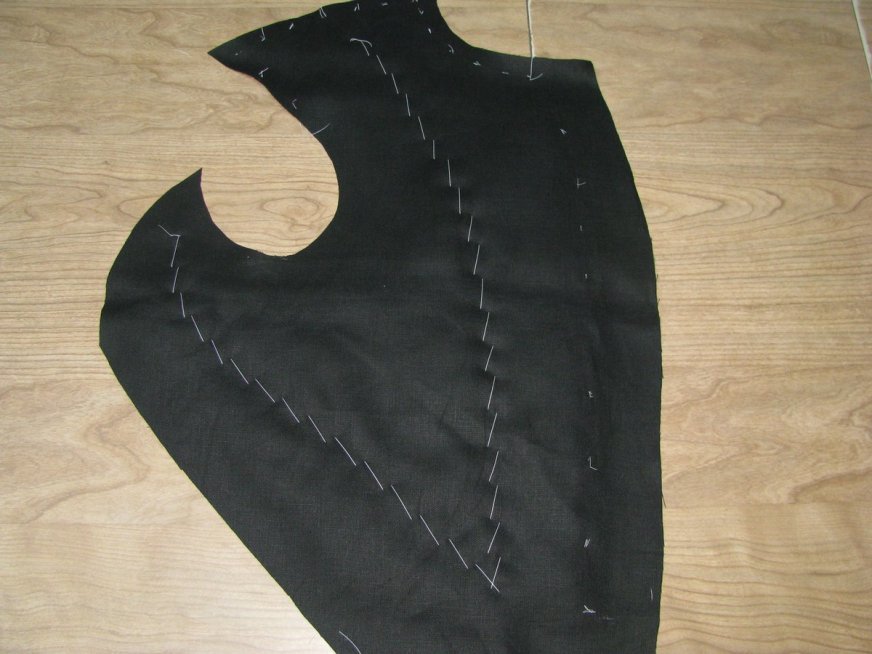
Then baste completely around the edges of the lining, catching all layers.
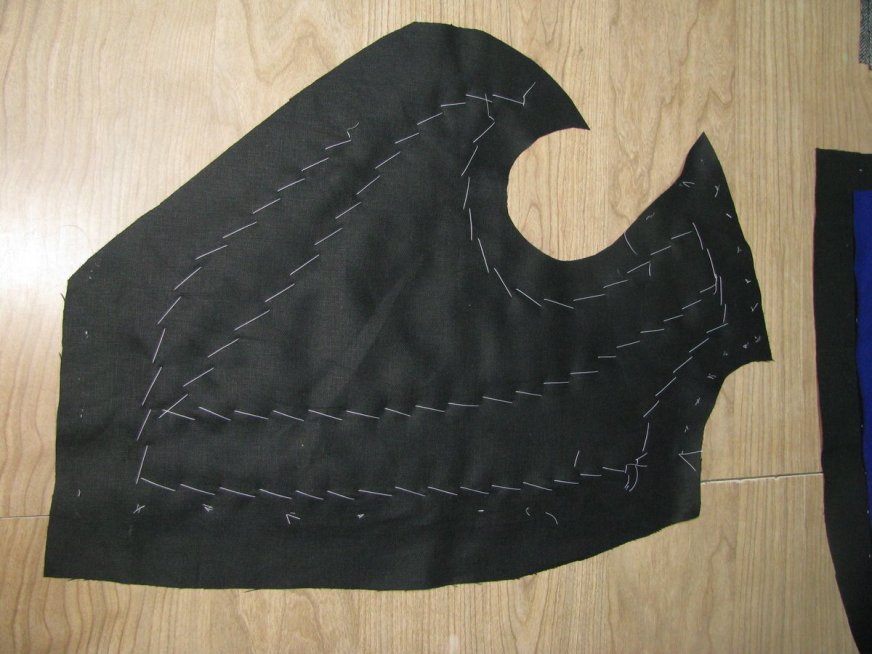
Finally, baste across the middle in a zig-zag formation, ensuring there will be no movement while quilting the layers. The exact pattern for this will vary according to each person’s individual pattern.

Cutting the Lining
Linings in enlisted frock coats for the most part only covered the fronts and sides. Full linings were sometimes seen in private purchase uniforms, however, they change the method of making up extensively and are outside the scope of this tutorial.
Here is the shape for the lining recommended by Devere. Begin by taping the forepart and side pieces together, making sure the seam allowances are overlapping properly. The pencil marks should be on top of each other.
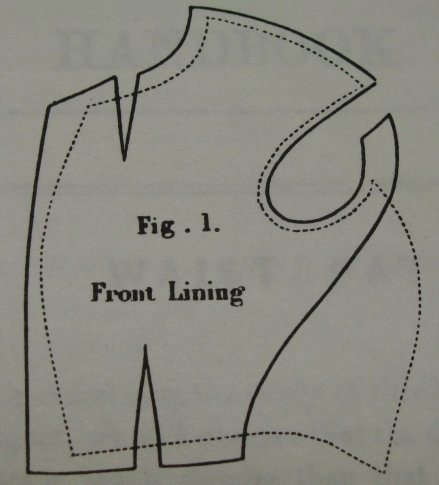

Fold up the bottom corner as shown. This is a matter of preference, as you can change the angle. The amount shown turned back in the photo is a good starting point, however.

Trace the pattern on to your black alpaca lining. Then add the same inlays you used when cutting the forepart. Check back to the module on cutting for a reminder if necessary.
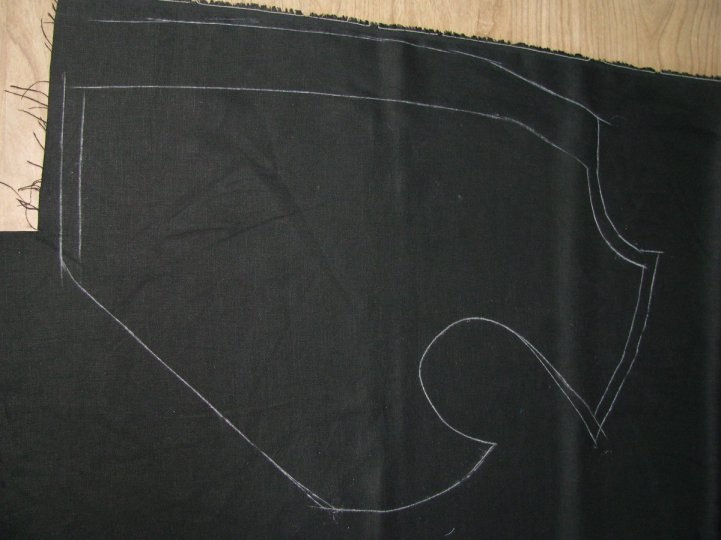
Add the tailor’s tacks to mark both pieces of lining.
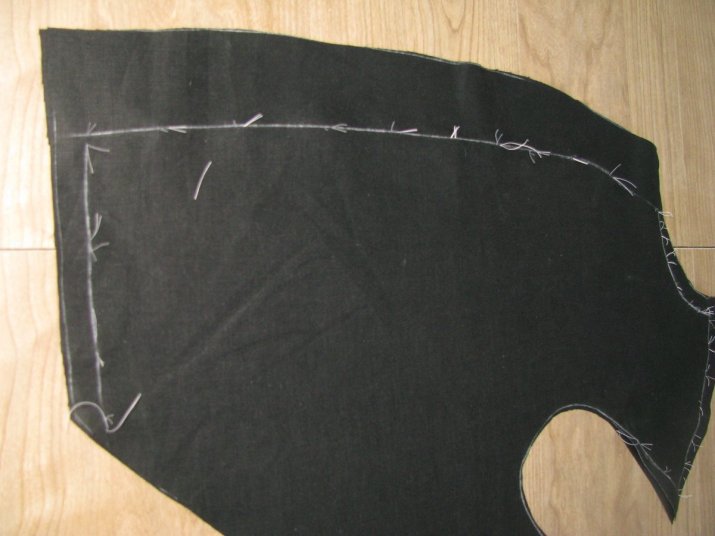
Next, lay the pattern on the red interlining or sacking, and trace around the pattern. Make sure the pattern is properly aligned with the grain. Next, subtract a half inch allowance from all sides, and one inch at the bottom waist seam. This will make the sacking smaller than the pattern.
Lay a piece of the sacking on top of the wool batting, and trim so they are the same size. Then carefully trim an additional half inch from the wool batting, thereby making it smaller than the sacking, and a full inch smaller all around than the lining. The reason for this is to help reduce bulk. If we left the pieces the same size, you would have a very bulky line where the edges met under the lining.

Finally, cut a smaller oval sized piece of wool batting. This piece should be small enough to stay at least half an inch away from the edge of the main piece of batting, again to reduce bulk. The shape is different for everybody, but should roughly correspond to the hollow you made in the forepart when shaping with the iron. If there is a large amount of hollowing in the chest, it’s possible to use even three layers of wool batting, all with stepped seam allowances. This is more likely to be necessary in the larger sized coats, or someone with a very thin waist.
If you find your batting is a bit wrinkled, give it a light ironing. Don’t press too hard or too long though, or you will flatten it, rendering it ineffective for padding the chest.
Second Fitting
Before beginning actual construction, you should do a forward fitting, to catch any last issues with the body and collar. Go through the following steps, but with basting only. Then go back and repeat the process with the actual sewing. You’ll want to baste the lining together as shown, but not quilt. Baste it into the coat. Baste the back and shoulders together. Then make a collar without the piping and baste that on. At this point you can still adjust the shoulder seams if necessary, and move the collar higher or lower. After fitting, remove all unnecessary seam allowances from the neck, shoulder, and back neck.
Added August 23, 2023:
Finding the Center Front
I’ve found that often times the way the historical pattern is drafted does not account for say having more of a belly or needing more room in the back waist or vice versa, and the center front is not where it actually needs to be. So to fix that, I give a very generous inlay of 2″ to the front, and after the canvas and lining are temporarily basted in, try on the coat.
Gently pinch the center front together, wrong sides together, so it is snug but not overly tight. Do this at the waist and then every two or three inches as you work your way up, marking the point on each forepart where the fabric is pinched together.
I’m demonstrating here on a finished coat, but on your coats the front edges will still be unfinished at this point.
Here I’m pinching the coat together at the center front, wrong sides together.
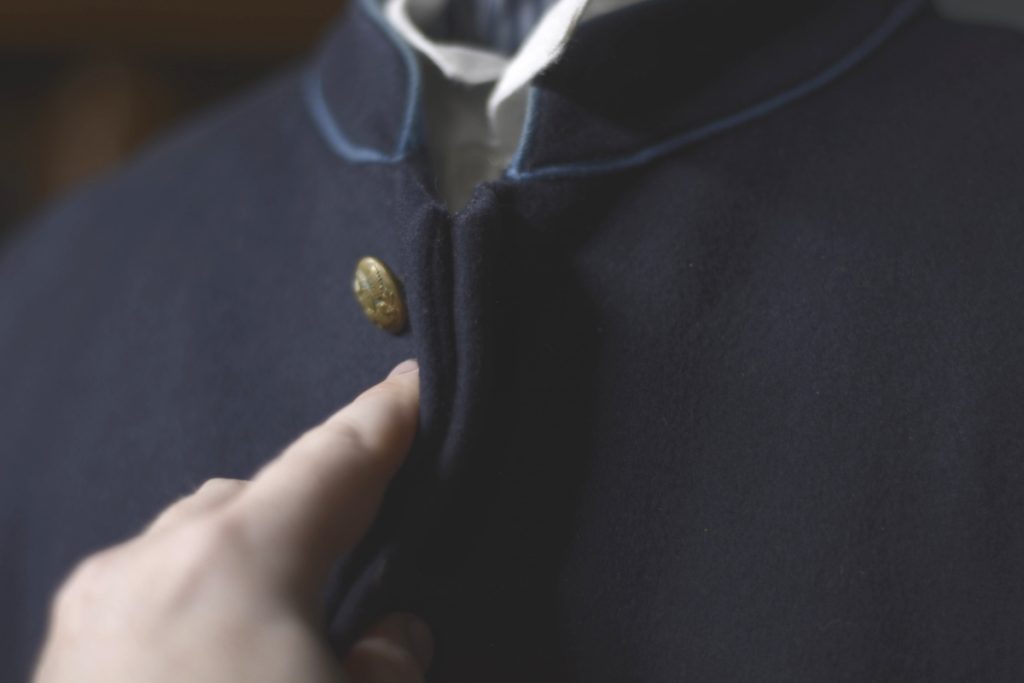
Mark each side of the coat at the base of the pinch.
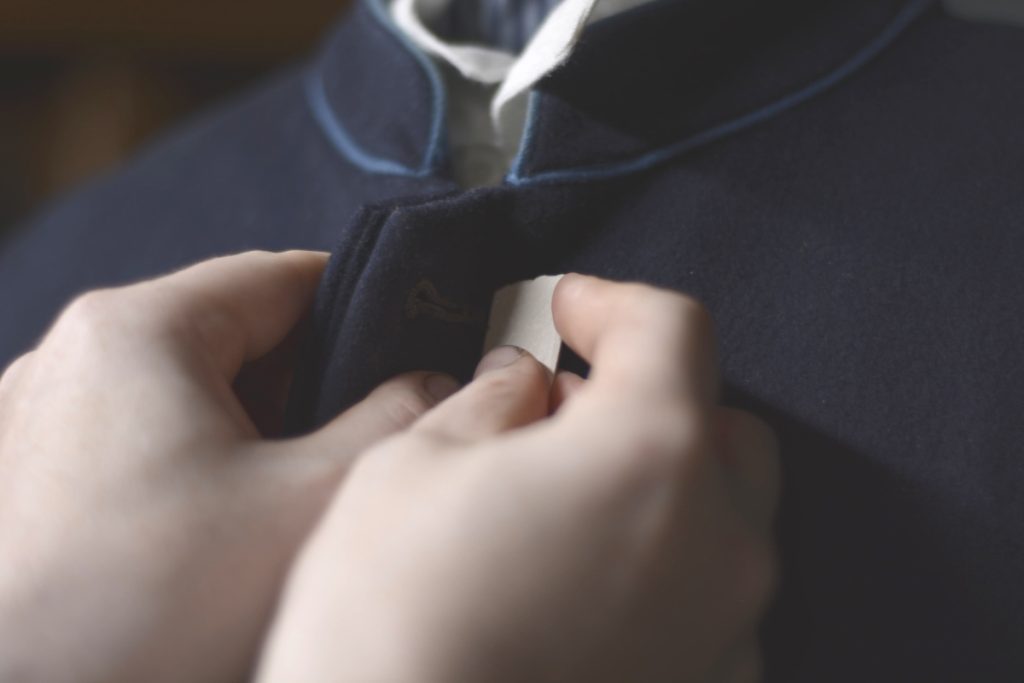
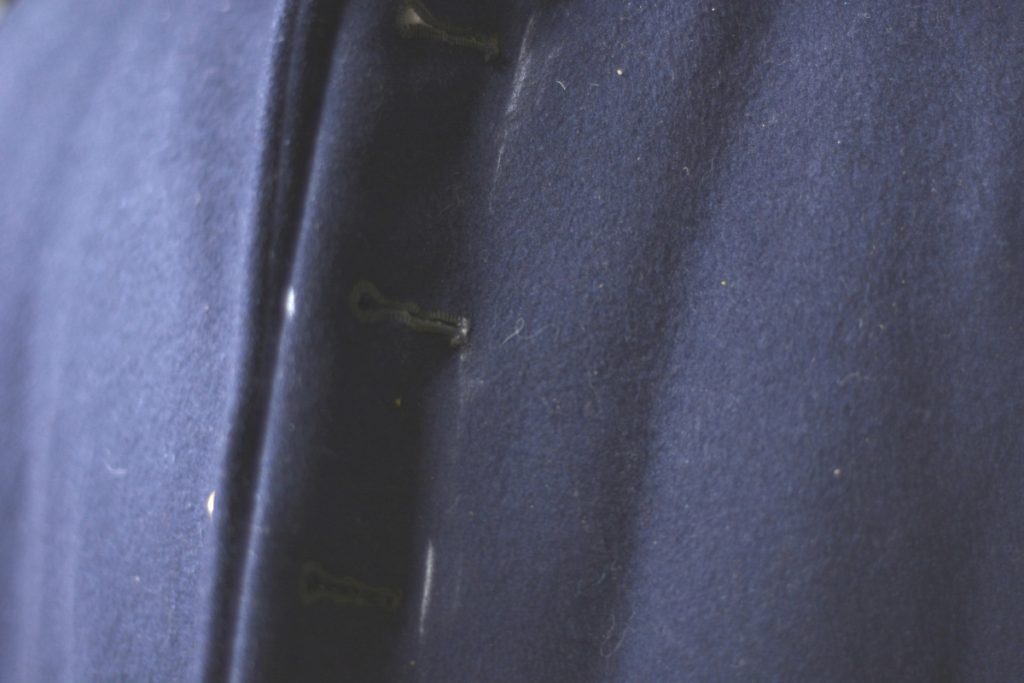
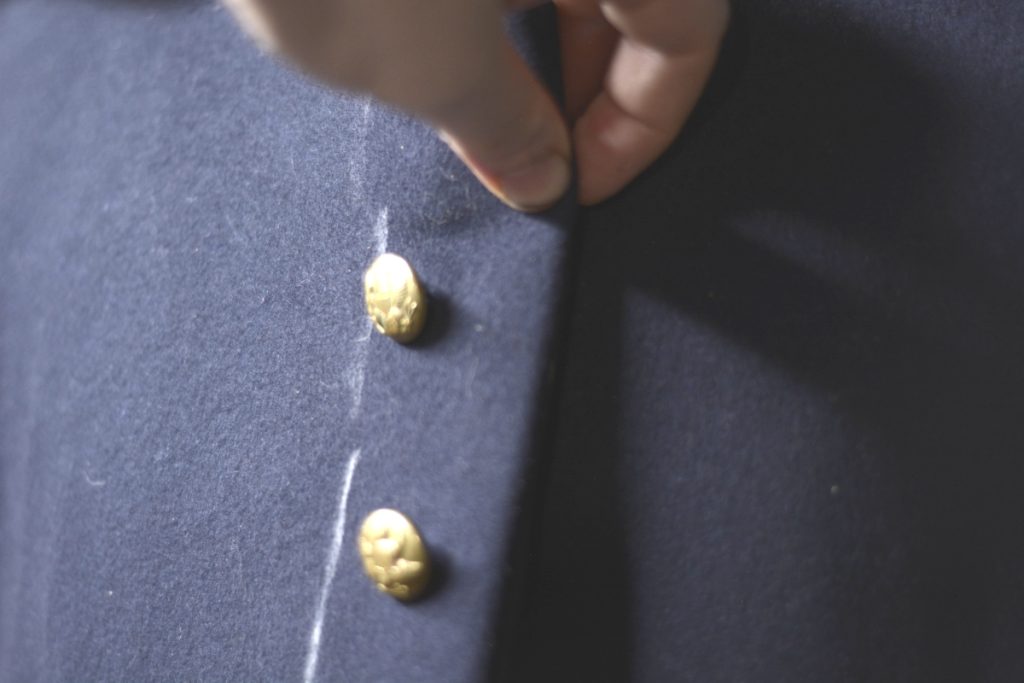
Here is the collar area on an unfinished coat after I’ve done this process.
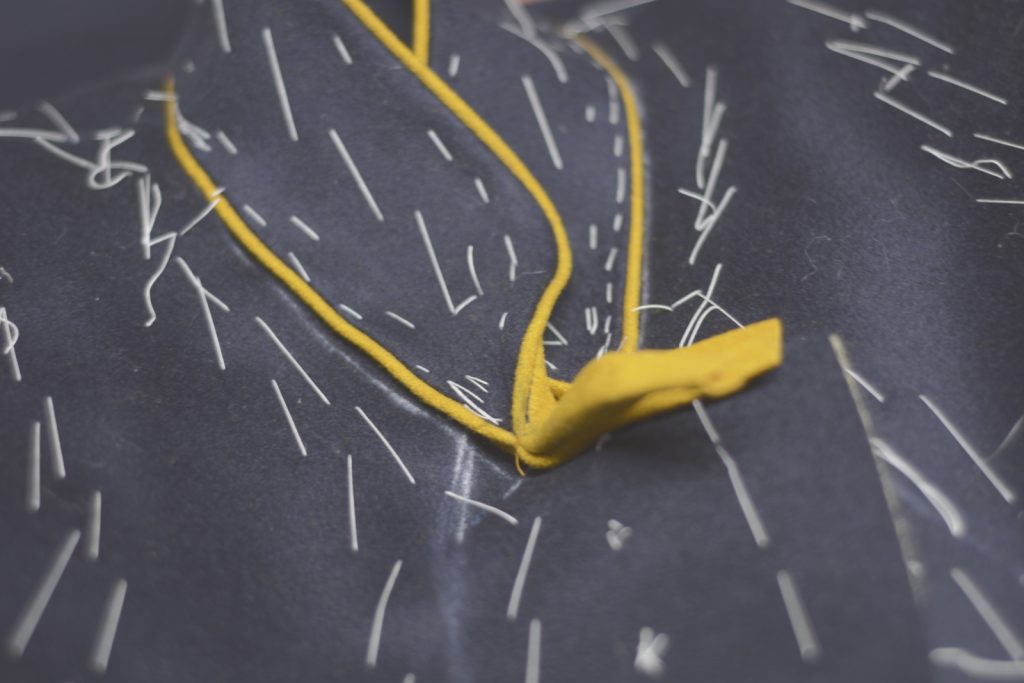
Next, I’ll connect the markings with a hip curve, as well as correct any slight inconsistencies in my marking – something marked a 1/4″ outside of the curve for example, or making sure both sides are identical.
This line keep in mind is the center front. After I’m happy with the corrected center front line (you can try it on again and pin along the lines instead of pinching), add 7/8″ to the center front on each side, 1/2″ for the space in front of the buttons and buttonholes, 1/4″ for the seam allowance, and 1/8″ to account for the turn of the cloth.
Leave the extra fabric on for now, but when you get to the appropriate section, you’ll trim the center front to this outer line and continue on from there.
If you have any questions about this section, please let me know. It’s really one of the most important parts of the fitting process, I’ve found.
Installing the Canvas
We will begin basting in the canvas now, working in even more shape as we go along. You’ll notice that neither the canvas nor the forepart want to lie flat on the table. The human body is not flat, so why would a coat be flat?
Keep this in mind as you’re basting in the canvas. Keep one hand underneath the canvas as you go, making sure the shape is supported as you baste.
To begin, lay the canvas on the table, with the coat, right side up, on top. The canvas should extend about 1⁄2” past the edge of the wool, giving us some room for error as we baste.
Start by basting from about an inch or two away from the top of the shoulder, down the center of the coat, ending one inch above the waist.
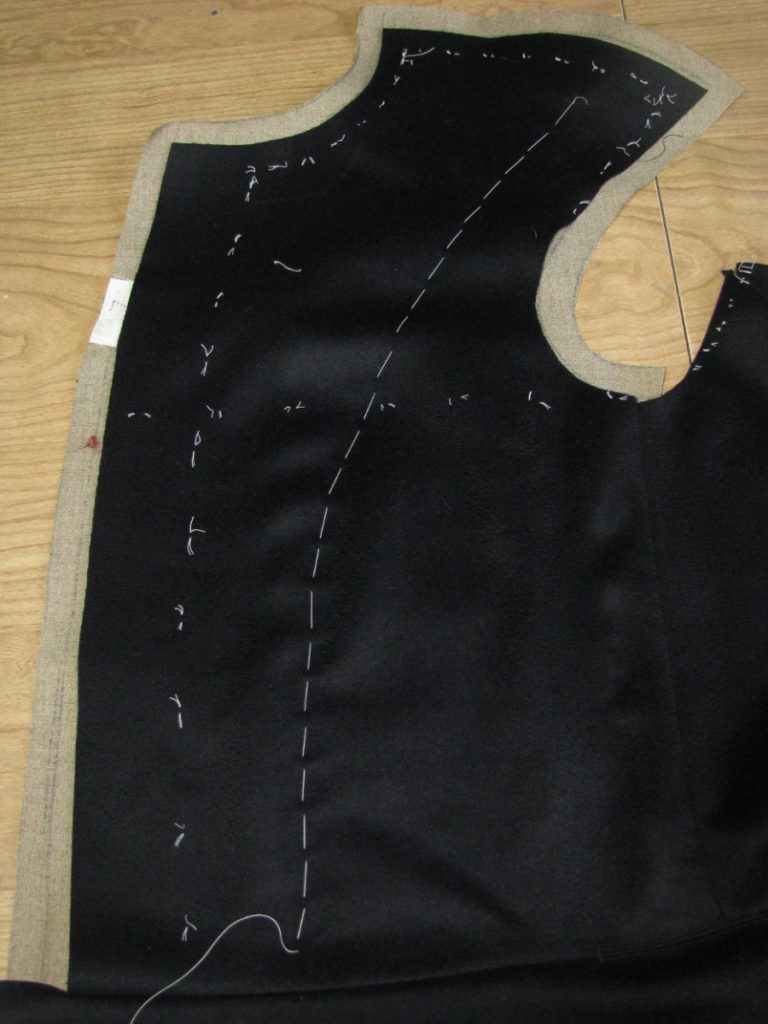
At the waist, baste toward the edge of the coat, stopping at the tailor tacks on the front of the coat. Then follow the front upwards, smoothing the fabric toward the edge as you go.

Keeping one inch away from the inlays, baste across the neck and shoulder, ending where you originally started.

Baste from the bottom of the scye, down along the edge of the canvas, to one inch above the waist, cutting across to meet the other basting you put in.

Finally, baste around the armscye, about a half inch from the edge. Also baste the rest of the waist line from the tailor tacks to the center front.
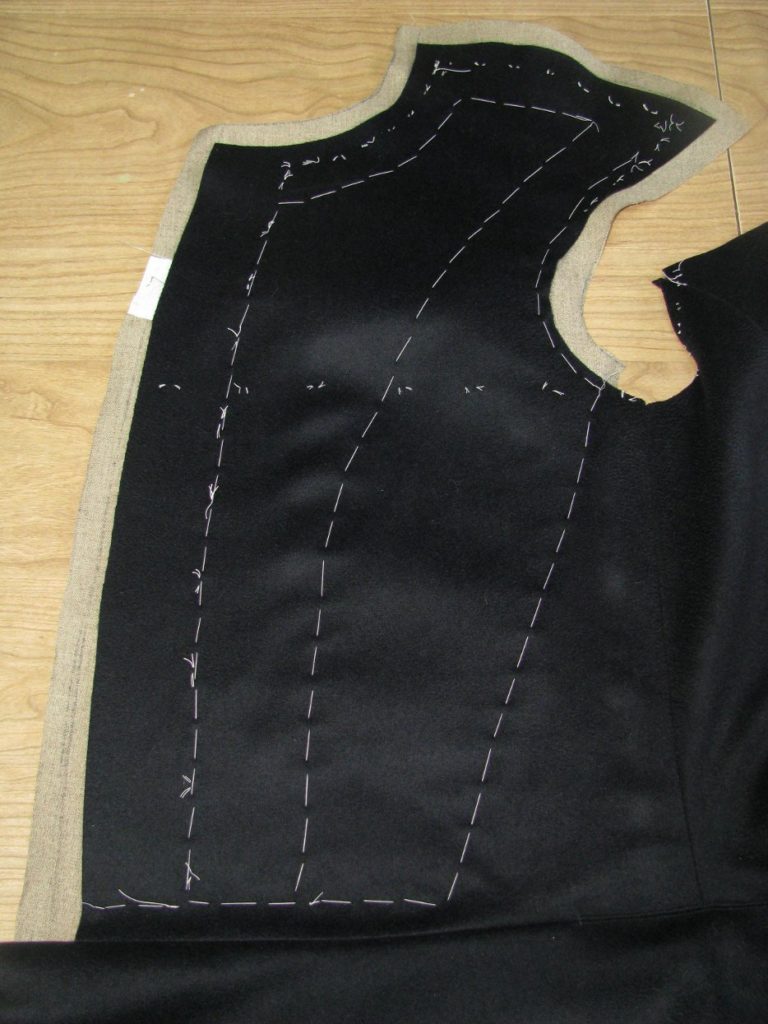
At this point, hold up the garment, being careful to support it fully to prevent unwanted stretching, and ensure that there are no ripples or unwanted fullness in the coat front. If there is, remove the basting and try again.
When you are satisfied, carefully trim the extra canvas from the edges of the coat along the center front, neck, shoulder, and armscye.
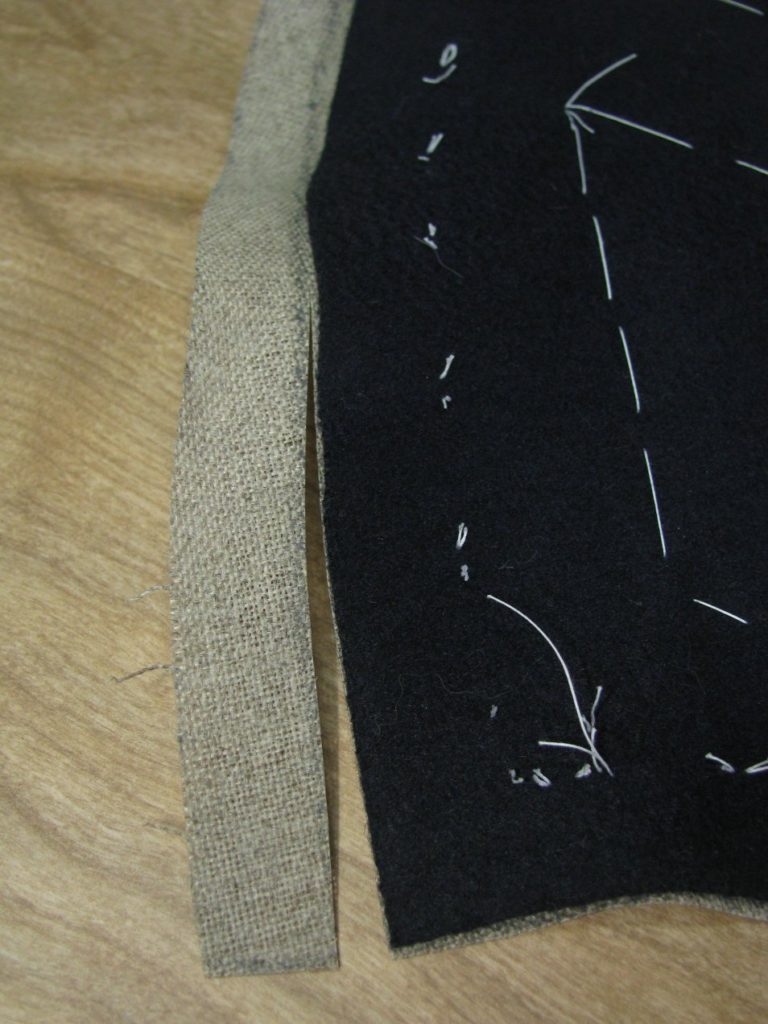
Turn the coat to the inside, and observe the waist seam. There should be about an inch extra inlay, which will need to be trimmed off carefully. The canvas edge needs to lay perfectly even with the waist seam.
With your scissors in the ‘ditch’ of the waist seam, carefully cut away this extra canvas. Cut a little bit at a time, and check between each cut that you are cutting accurately. If you cut too much away, the coat front will be pulled upwards and give an unsightly appearance. It’s okay to leave about 1/16 inch extra canvas. The extra fullness in the canvas will keep the wool in shape.
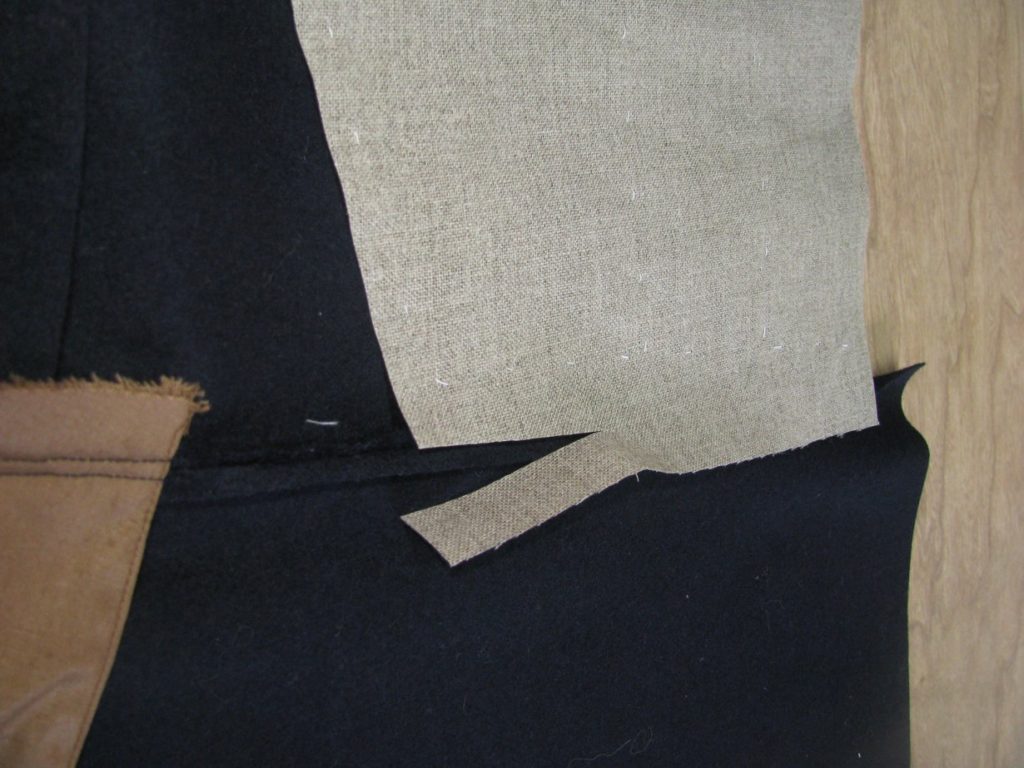
Using a cross stitch, secure the canvas to the waist seam of the coat. This will hold it permanently in place. Stitch from the inner edge of the canvas, to about two inches from the center front, where the tailor tacks are. You can use the basting stitches holding the canvas in place as a guide.

At this point you should have two halves of the coat completed, with pleat pockets and canvas installed. Here is the progress so far:
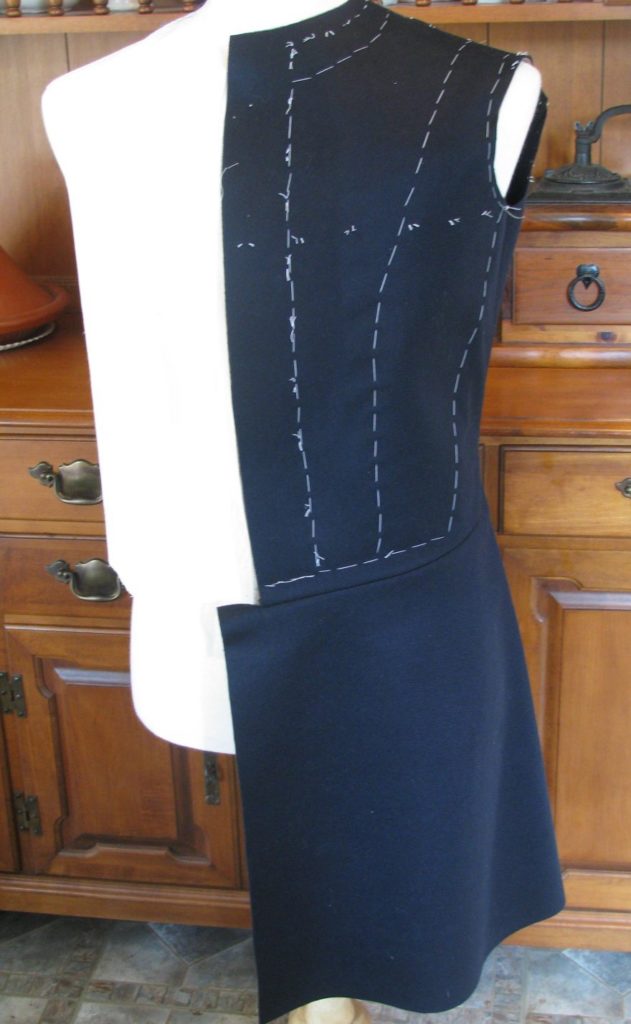
Cutting the Canvas
The canvas has a very large affect on the final appearance of a coat. It provides shape and support for the garment. The shape of the canvas will mimic the shape of the coat we created through ironwork, making it more permanent.
Lay the forepart pattern on your canvas, making sure the grain lines are lined up. Next, trace around the entire forepart with chalk, except for the side seam. The canvas does not extend all the way to the side seam. Instead, it extends in a concave line from a point about an inch away from the top of the side seam, to about halfway along the waist line, as shown.
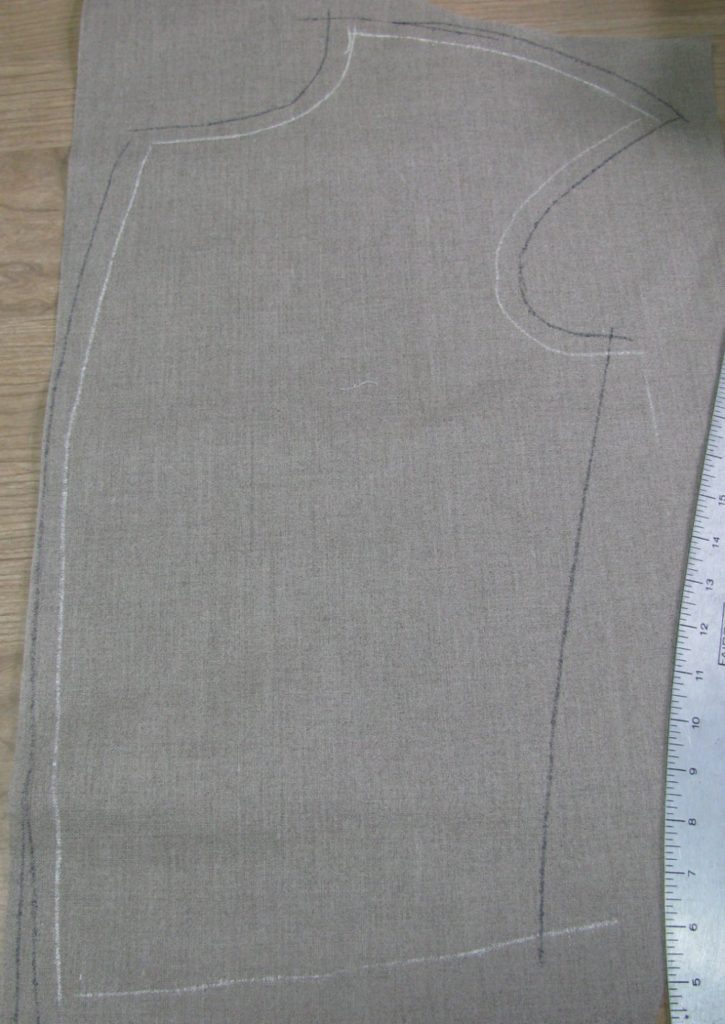
Next, add a half inch allowance all the way around, except for the side seam. This is to give you some room for error when basting on the canvas later, as they rarely line up perfectly.
Begin by laying your canvas pieces out as shown. You may want to mark the wrong sides for future use, though it doesn’t matter which side is up at this point, as long as they are mirrored.
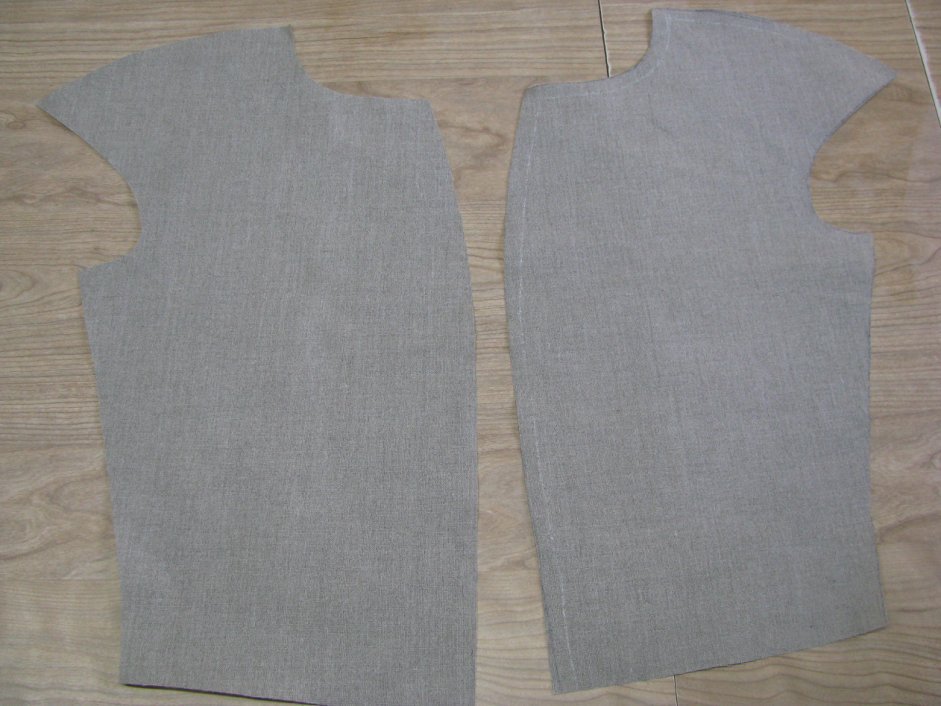
Perform ironwork on the armscye, shoulder, and neck, exactly like you did on the forepart itself.
Mark a line two inches in from the center front. This is to roughly correspond with the marking threads on the front of the coat.
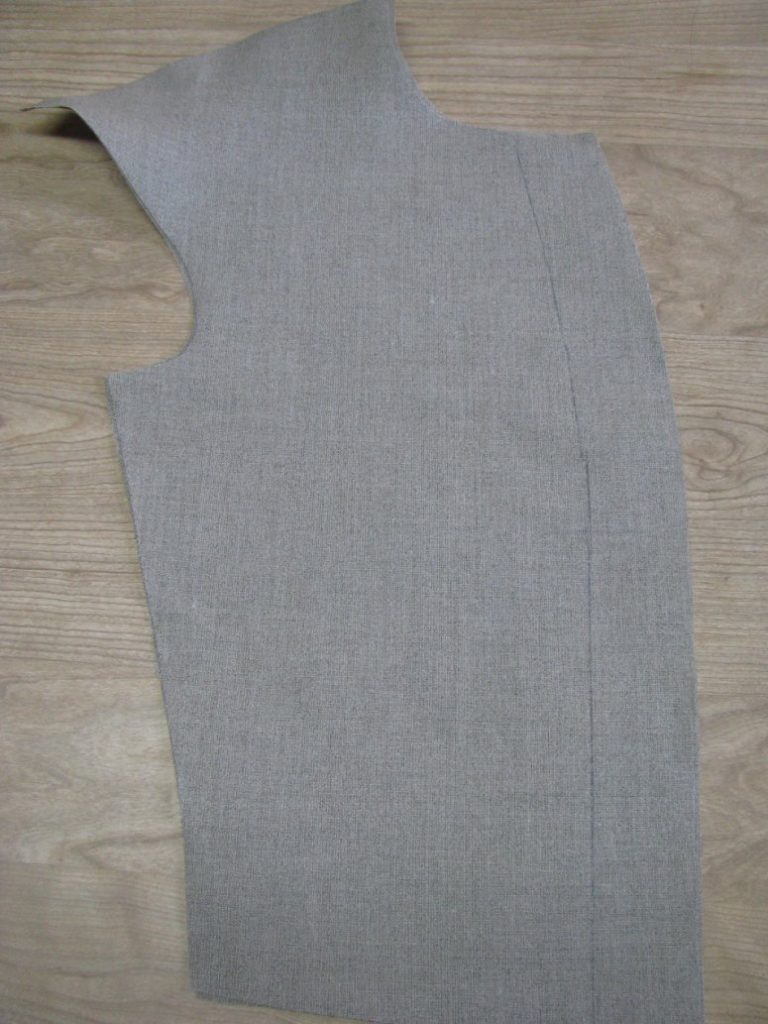
Darts must be placed in front of the coat, taking out a total amount equal to that which you shrunk from the front of the forepart. Each dart must be no larger than a half inch, and the total amount taken out should be no more than one inch, as for the forepart. For example, if I shrunk away 3⁄4 of an inch in the forepart, I would make two darts, each 3/8 of an inch wide.
In my case, I only needed to shrink out a half inch, so I will put one half inch dart in the canvas. Determine the location you want the darts, by finding the most curved section of the center front. Devere shows us his recommended locations in his 1866 manual.
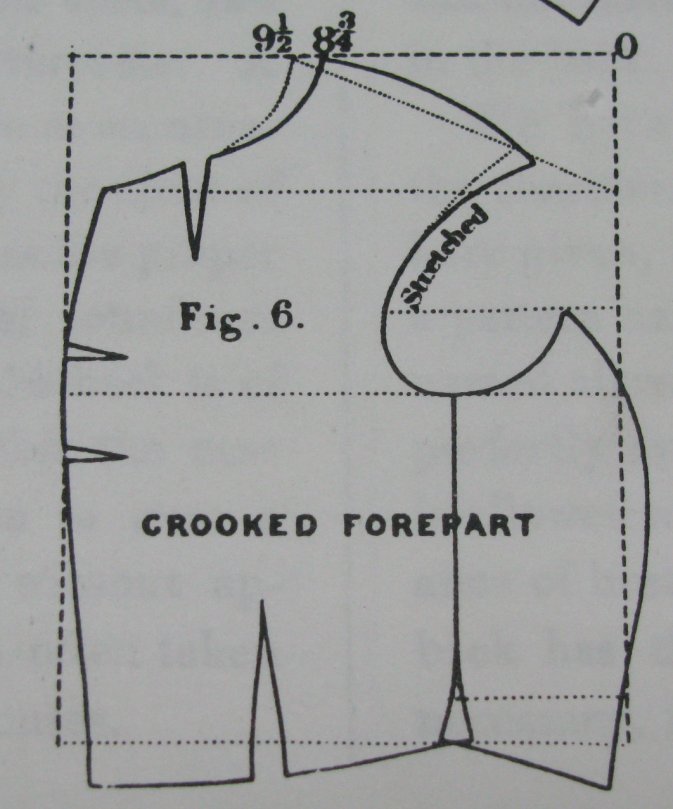
Start by drawing the center construction line of the dart at a right angle to the marking line you made two inches from the edge. The line should be about three inches long. Mark half the dart width to each side (in my case, 1⁄4”), and connect, forming a triangular dart as shown. The two outer lines should extend all the way to the edge of the canvas.
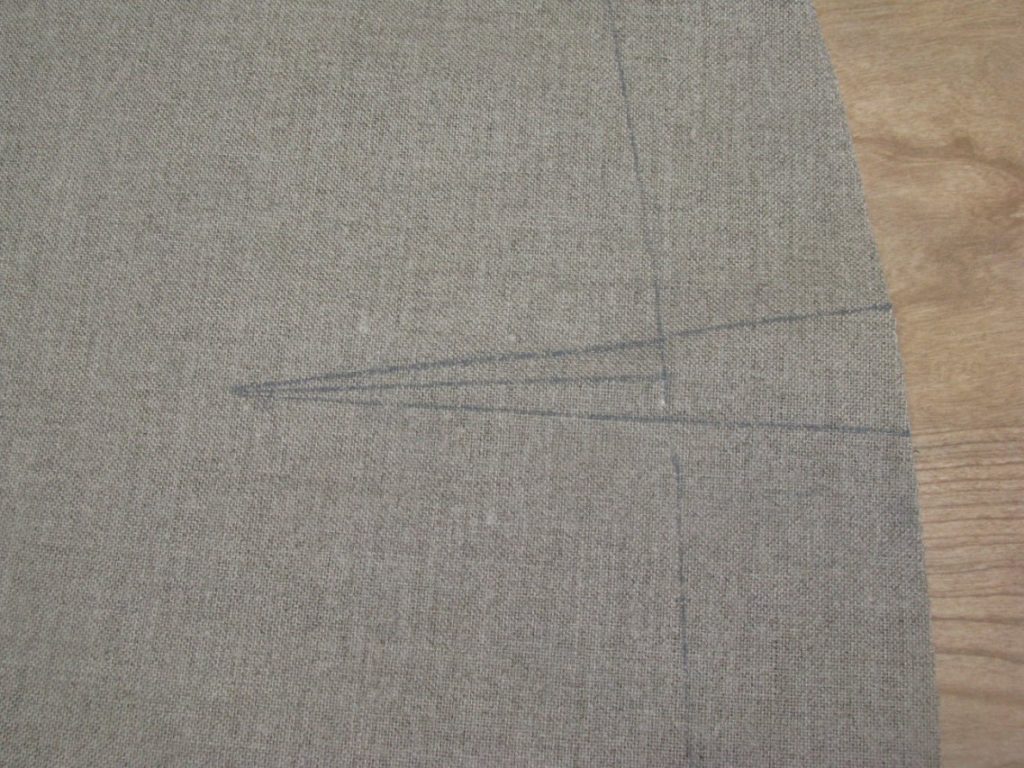
What this is doing is ensuring the dart is the proper width at the center front line, instead of the very edge of the coat. If you measure the dart from the edge of the coat instead, you will find the dart is too small, and have little affect on the coat’s shape.
Now place both canvas pieces together, and cut out the darts at the same time, on the inner edges of the chalk marks. You are cutting directly on the seam lines, as having a normal seam in the canvas would be too bulky.
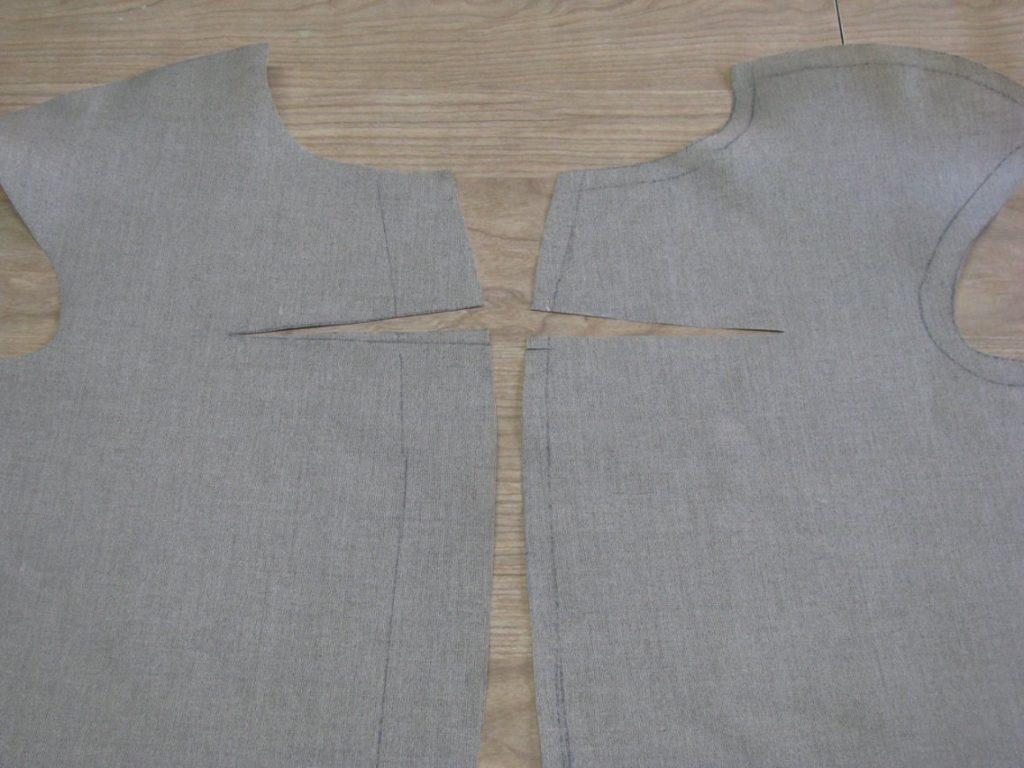
Here is a new method I learned very recently to sew the darts together in a traditional manner. This proves that there is always something new to learn in tailoring, no matter what your experience.
Cut a strip of linen 1 inch wide, by about 1 inch longer than the total length of your dart. Stretch this lengthwise with your iron to prevent and unwanted stretching or shrinking later on.
Baste one edge of the dart to the bottom half of the linen. The edge of the dart should follow the grain line, and be as close to the middle of the canvas as possible.
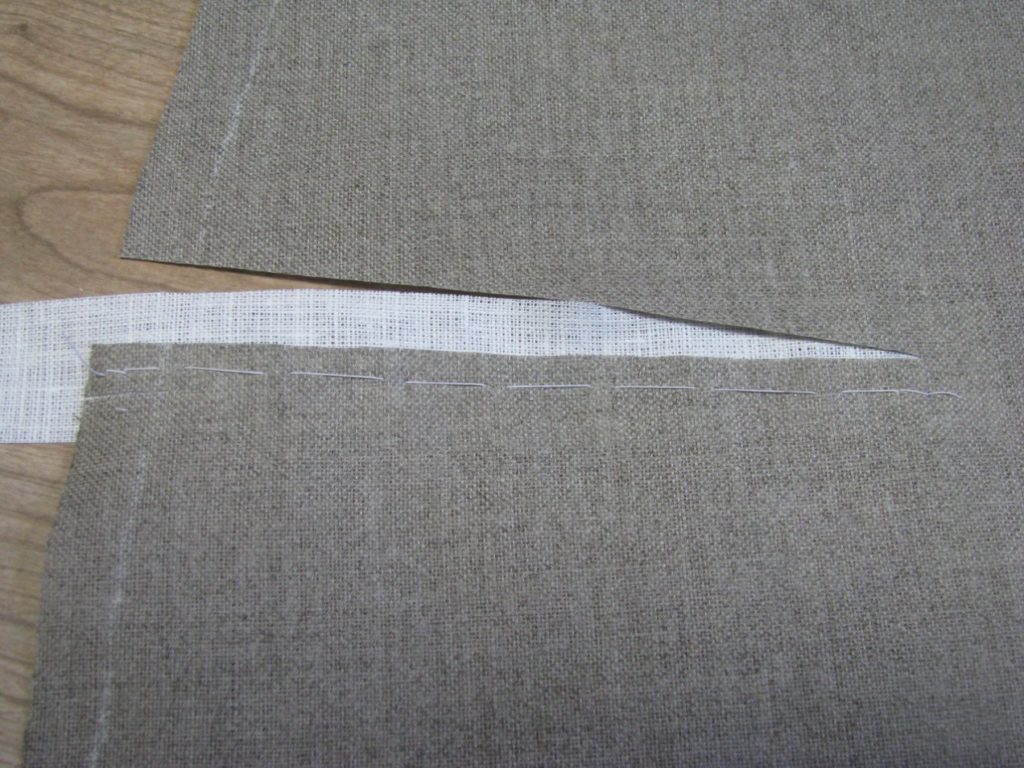
Baste the other edge of the dart on to the linen, butting the canvas edges closely together, but not overlapping.
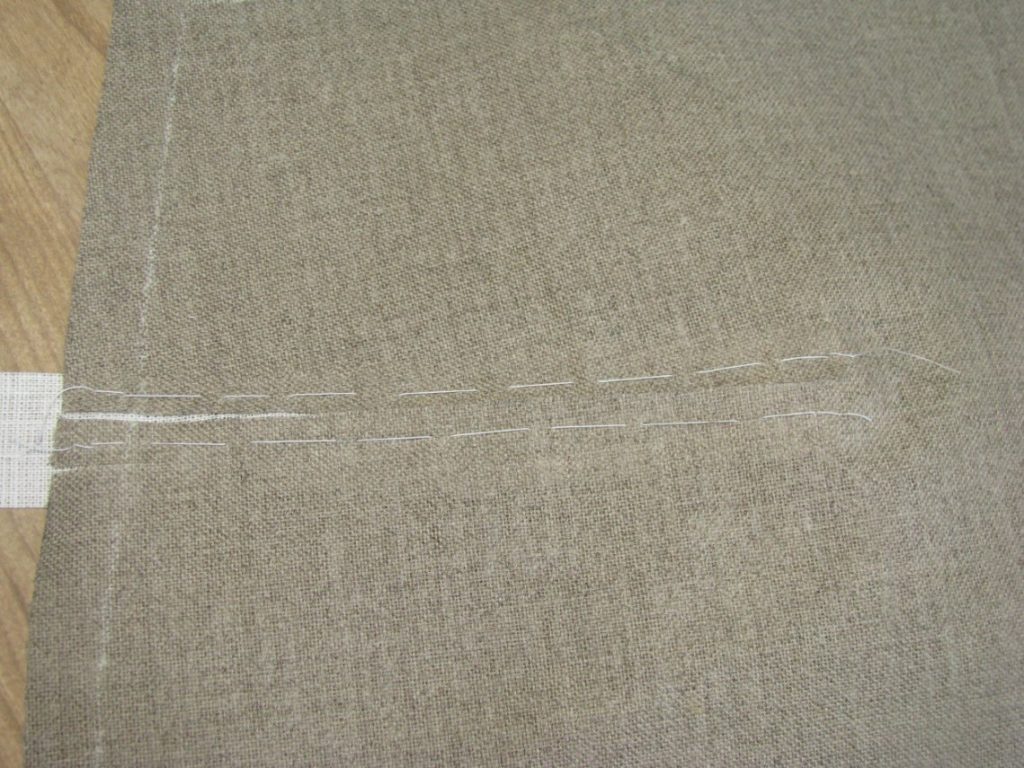
If you end up making the darts too large, you will end up with too much shaping in the front, and have a very ‘womanly’ look to the coat. If this happens, you can reopen the dart and insert a piece of scrap canvas, sewing it down along the edges of the dart. This will save you from having to cut another set of canvases. Then redraw new darts and continue as before.
Using a padding stitch on the linen side, stitch up the middle of the linen, catching both edges of the dart underneath. Hold the canvas so that the dart is pointing out in front of you, and hold the needle right to left as you insert it in the canvas.
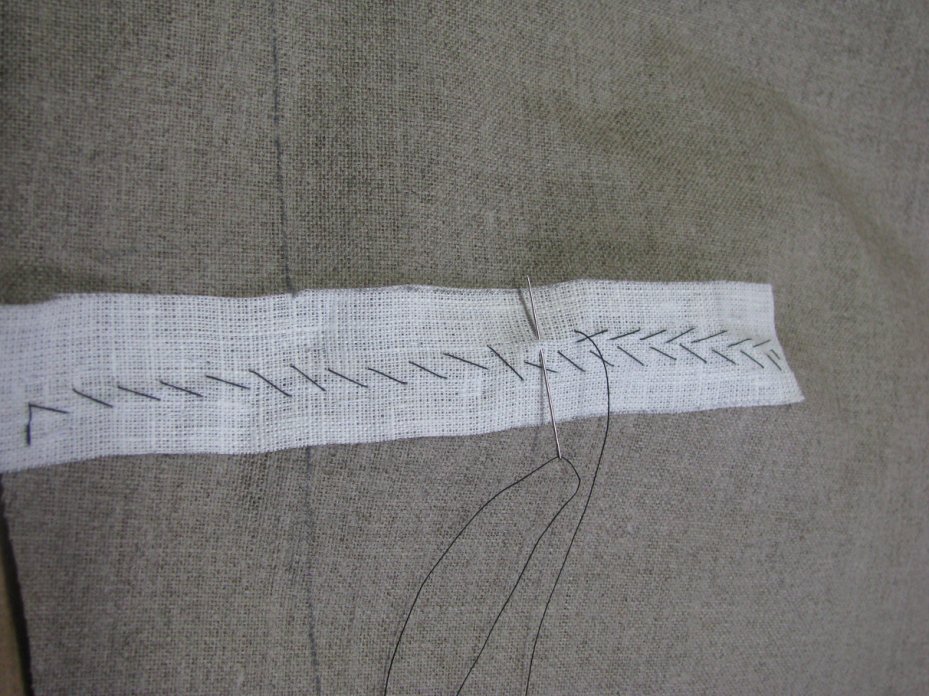
When you get to the end, don’t rotate the canvas, just start sewing back towards you, the needle going the same way. The second row should be to one side of the first row, and then you will keep working until you fill up that half of the linen.

Then start on the other half of the linen in the same manner. When completed, you should have several rows of nice stitching, holding the canvas firmly in place. Repeat on the other dart if applicable.
Prior to this method, I had been using a machine stitch to hold everything in place. And prior to that, when I first started tailoring, I would sew the darts with the same method as used for the outer wool fabric, creating a thick bulky seam. It’s nice to look back on your own work to see the progress you have made.
Installing the Plait Pockets
Lay the coat on the table right side up, and turn over the back piece so that the wrong side is up. Place the pocket, facing side down on top of the back. The top edge of the pocket should lie flush with the top of the pleat inlay.
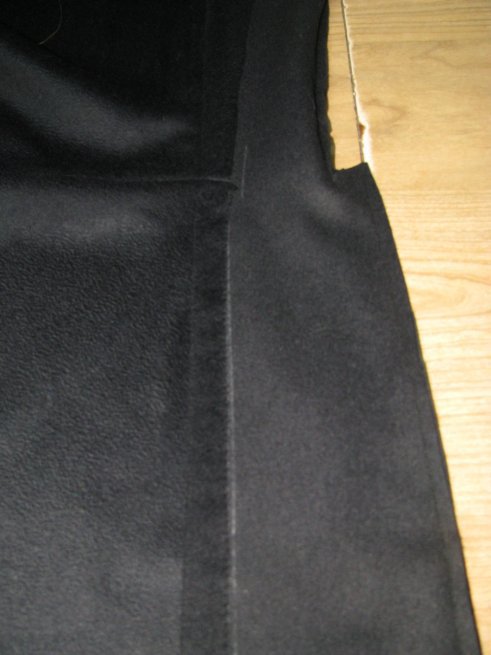

Starting at 1/16 inch below the facing, baste the pocket in place from that point, to the bottom of the pocket. Start with a few stitches in place to ensure that this point below the facing will not move at all.
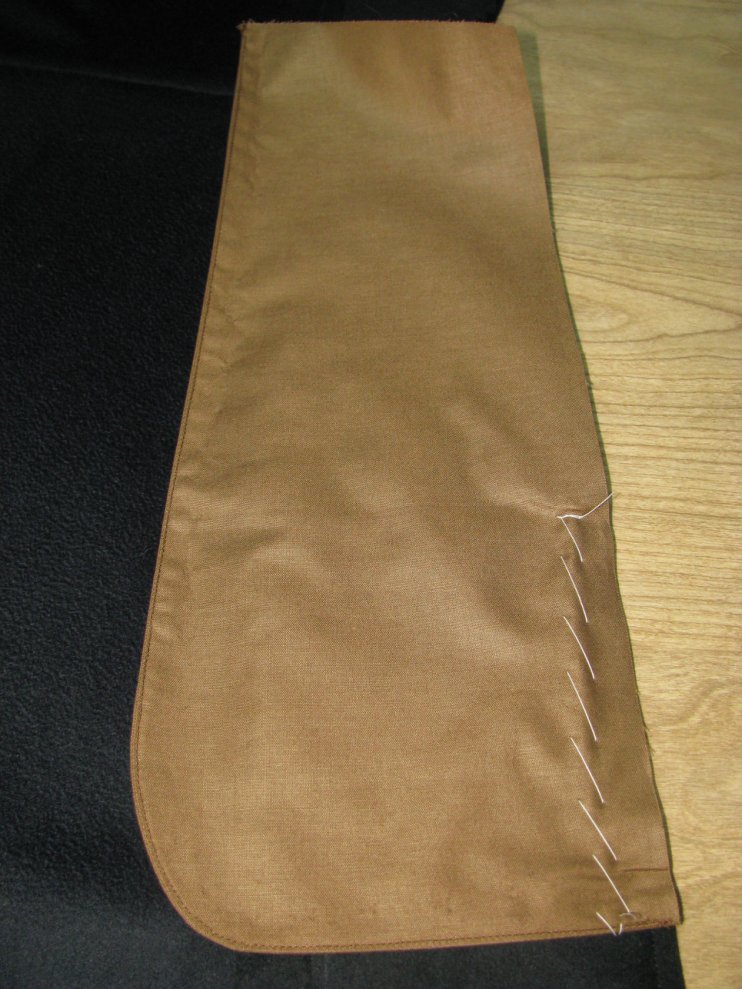
Then just above the middle, start basting towards the top. However, you need to move the bottom facing piece out of the way of this basting, so that it does not get caught in the seam.
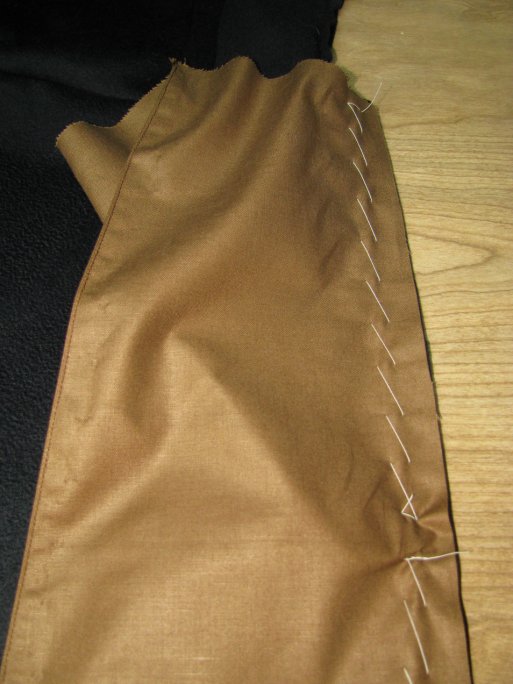

Now sew the pocket down along the edge, using a 5/16” seam. This is just a smidge wider than normal, and will hide the seam line you created when sewing the back piece to the skirt. When you get to the middle, where the facing is close to the seam line, take care not to actually catch the facing, but come as close as you can to it. If you do accidentally catch it, you’ll have to unpick the stitches and try again.

Remove the basting stitches, and press the pocket away from the body as shown. Don’t forget to press the underside beneath the facing. Keep the pocket in this position for the next step.

Now baste the facing to the body of the coat, so that it will not move. At the bottom of the facing, sew a stay stitch to secure the bottom of the pocket mouth, and give it some extra strength.
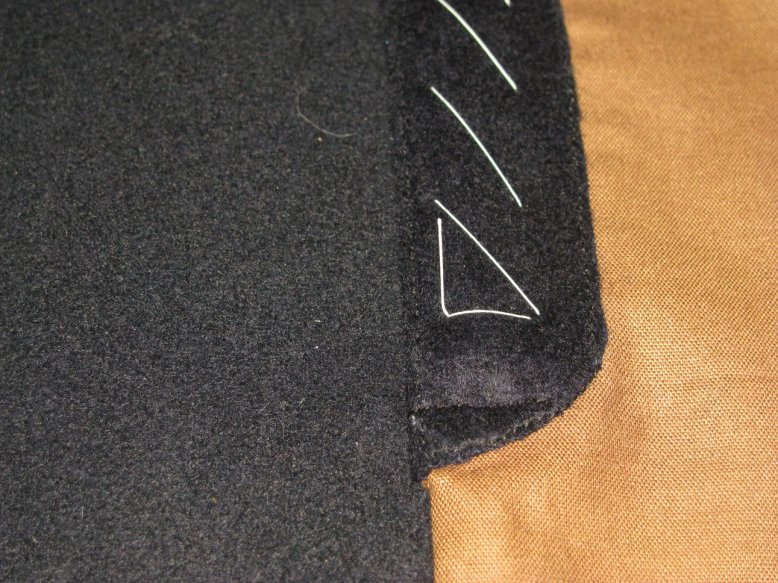
Open the coat completely now so that the wrong side is up, as pictured. Adjust the pleats so that they lie evenly. You may want to baste the pleats in place to make the next step easier. I haven’t only because I’ve done this so often. Notice how the top of the pocket follows the curvature of the waist seam. If we had cut the pocket straight across at the top, it wouldn’t have reached the seam at this step, and created a lot of tension in the coat.
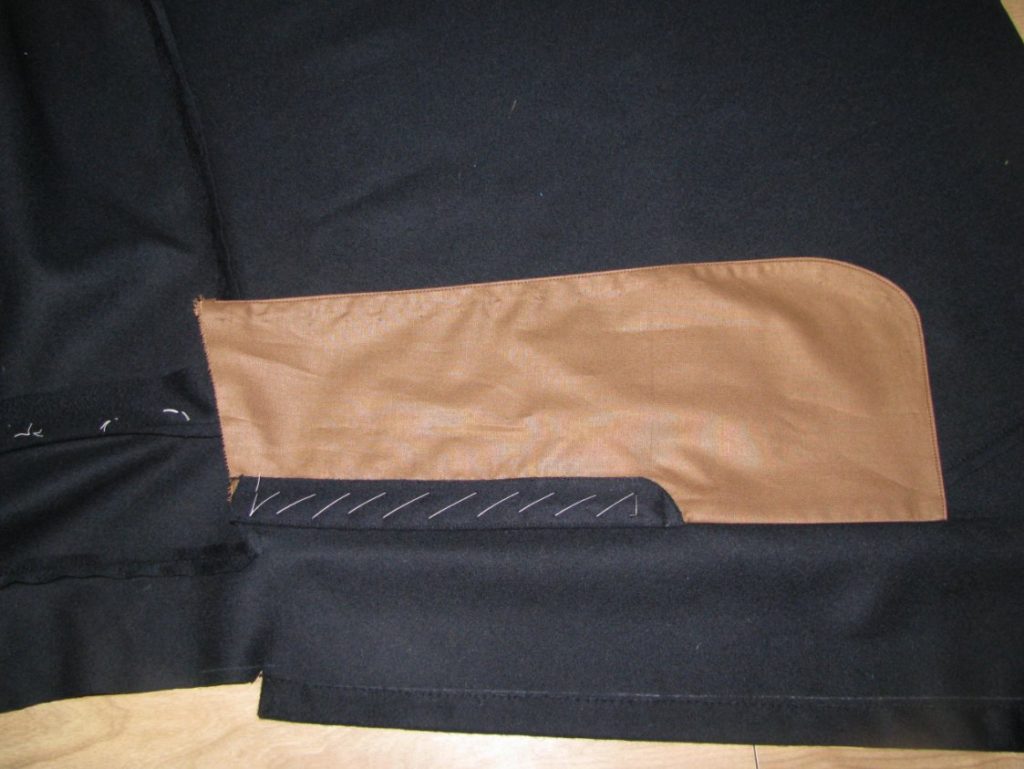
Baste across the top of the pocket, making sure the edges are quite secure. You don’t want any movement during the next step, which is very difficult under the best of circumstances.

From the outside of the coat, mark the points on the waist seam corresponding with the ends of the pocket and facing. Using the presser foot as a guide, sew a box stay, 1/8 inch from the waist seam, from chalk mark to chalk mark. When you get to the point where the waist seam meets the side seam, there is a lot of bulk. Take your time, turning the wheel by hand. At the ends, turn at 90 degree angles and complete your rectangular box. The end with the facing is also difficult to sew. Use a size 100 needle for best results.
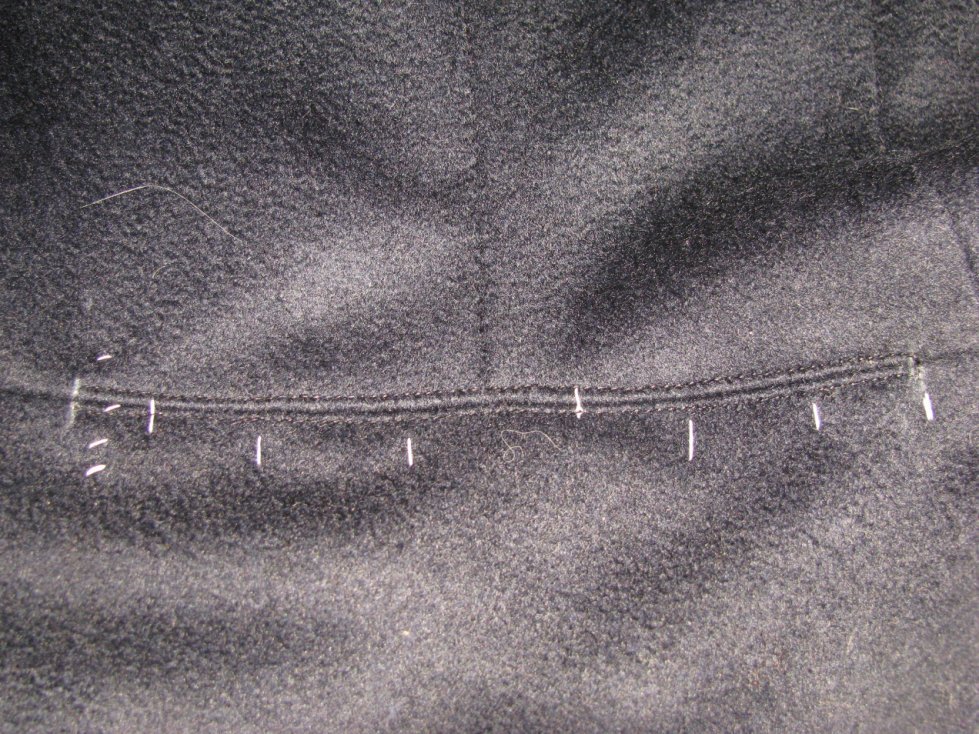
This is very visible on the finished coat, so make sure it comes out right. Don’t be afraid to unpick the stitches and try again, however difficult. The results will be worth the extra effort. And again, you may use a side stitch by hand here, if desired.
At this point, the pockets are completed! Remove all basting stitches, and give a good press from the wrong side before moving on to the canvas.
